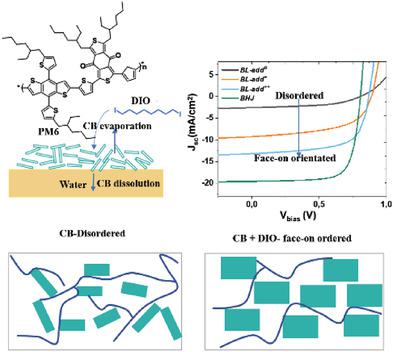当前位置:
X-MOL 学术
›
Adv. Mater. Interfaces
›
论文详情
Our official English website, www.x-mol.net, welcomes your
feedback! (Note: you will need to create a separate account there.)
Tailoring the Nature of Interface States in Efficient and Stable Bilayer Organic Solar Cells by a Transfer-Printing Technique
Advanced Materials Interfaces ( IF 4.3 ) Pub Date : 2022-04-14 , DOI: 10.1002/admi.202200342
Rong Wang 1, 2 , Youyu Jiang 1, 3 , Wolfgang Gruber 4 , Yakun He 1, 2 , Mingjian Wu 5 , Paul Weitz 1 , Kaicheng Zhang 1 , Larry Lüer 1 , Karen Forberich 1, 6 , Tobias Unruh 4 , Erdmann Spiecker 5 , Carsten Deibel 7 , Ning Li 1, 6, 8 , Christoph J. Brabec 1, 6
Advanced Materials Interfaces ( IF 4.3 ) Pub Date : 2022-04-14 , DOI: 10.1002/admi.202200342
Rong Wang 1, 2 , Youyu Jiang 1, 3 , Wolfgang Gruber 4 , Yakun He 1, 2 , Mingjian Wu 5 , Paul Weitz 1 , Kaicheng Zhang 1 , Larry Lüer 1 , Karen Forberich 1, 6 , Tobias Unruh 4 , Erdmann Spiecker 5 , Carsten Deibel 7 , Ning Li 1, 6, 8 , Christoph J. Brabec 1, 6
Affiliation

|
Bulk heterojunction organic solar cells (BHJ-OSCs) are designed to overcome inefficient charge generation and limited exciton diffusion of organic semiconductors. However, there are some disadvantages involving inherent voltage losses, microstructure control, and operational instability. Bilayer solar cells (BL-OSCs) without mixed regions are free from these problems and offer a platform to explore the photophysical processes at the donor–acceptor interface. Here, a breakthrough for n-i-p BL-OSCs in charge generation efficiency is reported. A gradual adjustment of the molecular interface orientation of the polymer donor (PM6) is accompanied by the evolution of charge-transfer states and Forster energy transfer. Besides, less recombination losses and superior morphological stability of BL-OSCs are achieved at a PCE comparable to that of BHJ-OSCs with similar layer thickness. This investigation confirms the feasibility of manufacturing BL-OSCs by a transfer printing method and provides a versatile architecture to study fundamental interface phenomena in OSCs independent from microstructure disorder.
中文翻译:

通过转移印刷技术在高效稳定的双层有机太阳能电池中调整界面态的性质
体异质结有机太阳能电池 (BHJ-OSC) 旨在克服有机半导体的低效电荷产生和有限的激子扩散。然而,存在一些缺点,包括固有的电压损耗、微观结构控制和操作不稳定性。没有混合区域的双层太阳能电池(BL-OSCs)没有这些问题,并为探索供体-受体界面的光物理过程提供了一个平台。本文报道了 nip BL-OSC 在电荷产生效率方面的突破。聚合物供体 (PM6) 分子界面取向的逐渐调整伴随着电荷转移状态的演变和 Forster 能量转移。除了,在与具有相似层厚的 BHJ-OSC 相当的 PCE 下,实现了 BL-OSC 的更少重组损失和优异的形态稳定性。该研究证实了通过转移印刷方法制造 BL-OSC 的可行性,并提供了一种通用架构来研究 OSC 中的基本界面现象,而不受微观结构紊乱的影响。
更新日期:2022-04-14
中文翻译:

通过转移印刷技术在高效稳定的双层有机太阳能电池中调整界面态的性质
体异质结有机太阳能电池 (BHJ-OSC) 旨在克服有机半导体的低效电荷产生和有限的激子扩散。然而,存在一些缺点,包括固有的电压损耗、微观结构控制和操作不稳定性。没有混合区域的双层太阳能电池(BL-OSCs)没有这些问题,并为探索供体-受体界面的光物理过程提供了一个平台。本文报道了 nip BL-OSC 在电荷产生效率方面的突破。聚合物供体 (PM6) 分子界面取向的逐渐调整伴随着电荷转移状态的演变和 Forster 能量转移。除了,在与具有相似层厚的 BHJ-OSC 相当的 PCE 下,实现了 BL-OSC 的更少重组损失和优异的形态稳定性。该研究证实了通过转移印刷方法制造 BL-OSC 的可行性,并提供了一种通用架构来研究 OSC 中的基本界面现象,而不受微观结构紊乱的影响。

































 京公网安备 11010802027423号
京公网安备 11010802027423号